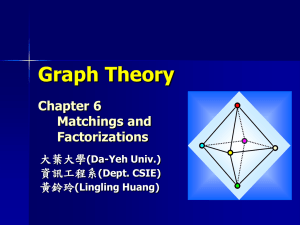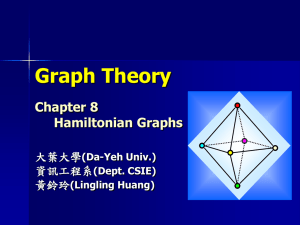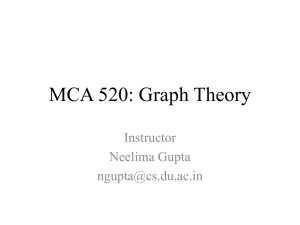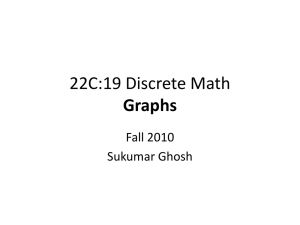V - 大葉大學
advertisement
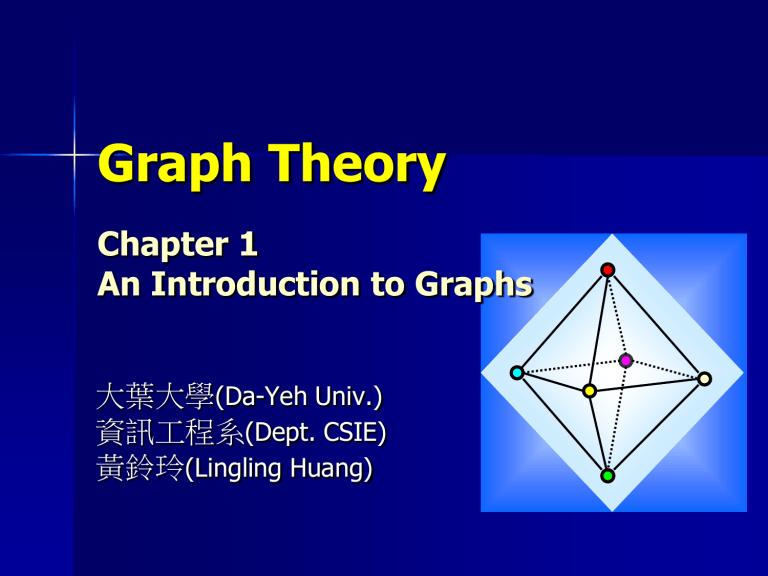
Graph Theory
Chapter 1
An Introduction to Graphs
大葉大學(Da-Yeh Univ.)
資訊工程系(Dept. CSIE)
黃鈴玲(Lingling Huang)
Outline
1.1
1.2
1.3
1.4
1.5
1.6
1.7
1.8
1.9
What is a graph?
The Degree of a Vertex
Isomorphic Graphs
Subgraphs
Degree Sequences
Connected Graphs
Cut-Vertices and Bridges
Special graphs
Digraphs
Ch1-2
Copyright 黃鈴玲
Graph Theory 的起源
1736, Euler solved the Königsberg Bridge
Problem (七橋問題)
Q: 是否存在一
種走法,可以走
過每座橋一次,
並回到起點?
(Ch7 Euler graph)
Ch1-3
Copyright 黃鈴玲
Königsberg Bridge Problem
C
A
D
B
Q: 是否存在一種走法,可以走過每條邊一次,並回
到起點?
Ans:
因為每次經過一個點,都需要從一條邊進入該點,再用另
一條邊離開,所以經過每個點一次要使用掉一對邊。
每個點上連接的邊數必須是偶數才行
此種走法不存在
Ch1-4
Copyright 黃鈴玲
An elementary example
of graphs
4 students: A, B, C, D
4 positions: FF, SC, W, BS
四人各有喜好的工作:(如下圖,連線表示有興趣)
FF
SC
W
BS
Q: Can all four
students find
jobs they like?
(Ch6 Matching)
A
B
C
D
Ans: No
Ch1-5
Copyright 黃鈴玲
Definition of a graph
A graph G is
a finite nonempty set V(G) of vertices (also
called nodes, 點) and
a (possibly empty) set E(G) of 2-element
subsets of V(G) called edges (or lines, 邊).
V(G) : vertex set of G (只有一個 G 時常簡寫為 V)
E(G) : edge set of G (只有一個 G 時常簡寫為 E)
常見的 edge 表示法: {u, v} = {v, u} = uv (or vu)
當邊有方向性時稱 G 為 directed graph (digraph)
Ch1-6
Copyright 黃鈴玲
Example
A graph G=(V,E), where
V={u, v, w, x, y, z}
E={{u,v}, {u,w}, {w,x}, {x,y}, {x,z}}
E={uv, uw, wx, xy, xz}
v
u
G 的 diagram
表示法:
w
x
y
z
Ch1-7
Copyright 黃鈴玲
Adjacent and Incident
u, v : vertices of a graph G
e
u
v
u and v are adjacent in G if uv E(G)
( u is adjacent to v, v is adjacent to u)
e=uv (e joins u and v) (e is incident
with u, e is incident with v)
Ch1-8
Copyright 黃鈴玲
Graphs types
loop
multiedges, parallel edges
undirected graph:
• (simple) graph: loop (), multiedge ()
• multigraph:
loop (), multiedge ()
• Pseudograph: loop (), multiedge ()
Ch1-9
Copyright 黃鈴玲
order and size
The number of vertices in a graph G is
called its order (denoted by |V(G)| ).
The number of edges is its size
(denoted by |E(G)| ).
Proposition 1:
p
If |V(G)| = p and |E(G)| = q, then q
2
A graph of order p and size q is called a
(p, q) graph.
Ch1-10
Copyright 黃鈴玲
Application of graphs
一群人間兩兩互相認識或不認識(i.e., 沒有A認識B但
B不認識A的情形),在安排一張圓桌的晚餐座位時,
是否存在一種排法能讓坐在一起的人都相互認識?
eg.
Tom, Dick know Sue, Linda.
Harry knows Dick and Linda.
acquaintance graph:
(連線表示認識)
Q: 圖中是否有一個通過
所有點的cycle?
(Ch8 Hamiltonian graph)
Tom
Dick
Harry
Sue
Linda
Ch1-11
Copyright 黃鈴玲
Application of graphs
動物園要用圍牆劃分區域,避免同區的動物互相捕食,
至少需分多少區?
eg. Animals: A, B, C, D, E
AC 不能與 BD 同區,
E不能與其他動物同區
Q: 將圖形的點著色 (一色表示一區),
若相鄰兩點需塗不同色,
最少需多少顏色才夠?
A
D
E
B
C
連線表示不能同區
Ans: 3 色 3 區
(Ch 10 Graph Coloring)
Ch1-12
Copyright 黃鈴玲
Homework
Exercise 1.1:
1, 2, 3, 4
Ch1-13
Copyright 黃鈴玲
Outline
1.1
1.2
1.3
1.4
1.5
1.6
1.7
1.8
1.9
What is a graph?
The Degree of a Vertex
Isomorphic Graphs
Subgraphs
Degree Sequences
Connected Graphs
Cut-Vertices and Bridges
Special graphs
Digraphs
Ch1-14
Copyright 黃鈴玲
1.2 The degree of a vertex
Definition.
For a vertex v of G, its neighborhood
N(v) = { u V(G) | v u E(G) }.
The degree of vertex v is
deg(v) = | N(v) |.
u
v
N(u) = {x, w, v}, N(y)={ }
deg(u) = 3, deg(y) =0
y
x
w
Ch1-15
Copyright 黃鈴玲
Notes
If |V(G)| = p, then
0 deg(v) p-1, v V(G).
If deg(v) = 0, then v is called an
isolated vertex (孤立點).
v is an odd vertex if deg(v) is odd.
v is an even vertex if deg(v) is even.
Ch1-16
Copyright 黃鈴玲
Handshaking theorem
Theorem 1.1 (Handshaking theorem)
Let G be a graph,
deg( v) | E(G ) | 2
vV ( G )
Example
u
2
v
3
deg( v) 8
vV ( G )
x
| E (G ) | 4
w
1
2
pf. 在計算degree總和時,每條邊會被計算兩次。
Ch1-17
Copyright 黃鈴玲
Handshaking theorem
Corollary 1.1
Every graph contains an even number of
odd vertices.
pf. If the number of vertices with odd degree is
odd, then the degree sum must be odd.
Ch1-18
Copyright 黃鈴玲
Regular graph
Definition.
A graph G is r-regular if every vertex of G has
degree r.
A graph G is regular if it’s r-regular for some r.
Example
Note.
There is no 1-regular graph
or 3-regular graph of order 5.
(by Corollary 1.1)
2-regular
Ch1-19
Copyright 黃鈴玲
Complement
Definition.
The complement G of a graph G is a
graph with V(G) = V(G), and
uv E(G) iff uv E(G).
u
v
G
u
v
w
x
G
w
x
Ch1-20
Copyright 黃鈴玲
Application of degree
Q: n people. (n 2)
Is it possible that every two of them are
acquainted with a different number of
people in the group?
(Suppose if A knows B, then B knows A.)
A: Consider the acquaintance graph。
若任兩人所認識的人數不等,
表示圖形中所有點的 degree 都不相等。
n 點的圖形中, degree 只可能是 0, 1, …, n-1 (共 n 種),
必有一點 x 的 degree 為 0,另一點 y 的 degree 為 n-1,
也就是 x 不認識 y ,但 y 認識 x ,矛盾。
Ch1-21
Copyright 黃鈴玲
Exercise 1
Prove that every graph of order n 2
has at least two vertices with the
same degree.
(Hint. The problem in previous page.)
pf. If not,
then there exist vertices x and y with
deg(x) = 0 and deg(y) = n-1.
It’s impossible.
Ch1-22
Copyright 黃鈴玲
Exercise 9.
Every vertex of a graph G of order 14
and size 25 has degree 3 or 5.
How many vertices of degree 3 does G
have?
sol. Suppose there are x vertices of degree 3,
then there are 14-x vertices of degree 5.
|E(G)| =25 degree sum=50
3x + 5(14-x) = 50
x = 10
Ch1-23
Copyright 黃鈴玲
Exercise 10.
A graph G of order 7 and size 10 has
six vertices of degree a and one of
degree b. What is b?
Try to draw the graph
sol. 6a + b = 20
(a, b) = (0, 20)
(1, 14)
(2, 8)
(3, 2)
a=3, b=2.
()
()
()
()
Ch1-24
Copyright 黃鈴玲
Homework
Exercise 1.2:
4, 7, 11
Ch1-25
Copyright 黃鈴玲
Outline
1.1
1.2
1.3
1.4
1.5
1.6
1.7
1.8
1.9
What is a graph?
The Degree of a Vertex
Isomorphic Graphs
Subgraphs
Degree Sequences
Connected Graphs
Cut-Vertices and Bridges
Special graphs
Digraphs
Ch1-26
Copyright 黃鈴玲
1.3 Isomorphic graphs
G1 v
1
v2
v3
v4
v5
G2
u1
u3
u4
u5
u2
v2
G1 and G2 are the same (after moving some vertices).
Ch1-27
Copyright 黃鈴玲
Isomorphic
Definition.
Two graph G1 and G2 are isomorphic (同構)
(denoted by G1 G2 ) if there is a 1-1 and
onto function from V(G1) to V(G2) such
that
uv E(G1) iff (u) (v) E(G2).
(對應過去後,仍能保持兩點間相連與否的關係)
The function is called an isomorphism.
In previous page, (vi) = ui for each i.
Ch1-28
Copyright 黃鈴玲
Isomorphic
Definition.
Two graph G1 and G2 are equal
if V(G1) = V(G2) and E(G1) = E(G2).
Proposition.
1. If G1 G2, then |V(G1)| = |V(G2)| and
|E(G1)| = |E(G2)|.
2. If G1 G2 and is an isomorphism from
V(G1) to V(G2), then
deg G1 (v) deg G2 ( (v)), v V (G1 )
(So the degree sequences of these graphs must be the same.)
1 跟 2 是判斷兩個圖是否 isomorphic 的初步檢查條件
Ch1-29
Copyright 黃鈴玲
Definition.
Trivial graph: The graph of order 1.
Exercise 1
Find two nonisomorphic 3-regular
graphs of order 6 and size 9.
Sol.
G1
G2
contain triangles
without any triangle
Ch1-30
Copyright 黃鈴玲
Exercise 8
Determine whether the graphs G1 and
G2 shown below are isomorphic.
G1
G2
without any triangle
Ans: No
contain triangle
Ch1-31
Copyright 黃鈴玲
Note.
1. 要證明 G1 G2 時,必須給出 isomorphism
這個函數,也就是必須明確說出 G1 的哪一點
對應 G2 的哪一點。
2. 要證明 G1 G2 時,只需說明原因 (如:點數
邊數不同,degree sequence不同,或圖形結
構哪裡不同等)。
所有點的 degree 排列成的數列,
通常由大到小排,1.5節會探討。
Ch1-32
Copyright 黃鈴玲
Homework
Exercise 1.3:
4, 7, 9
Ch1-33
Copyright 黃鈴玲
Outline
1.1
1.2
1.3
1.4
1.5
1.6
1.7
1.8
1.9
What is a graph?
The Degree of a Vertex
Isomorphic Graphs
Subgraphs
Degree Sequences
Connected Graphs
Cut-Vertices and Bridges
Special graphs
Digraphs
Ch1-34
Copyright 黃鈴玲
1.4 Subgraphs
Definition.
A graph H is a subgraph of a graph G if
V(H) V(G) and E(H) E(G). (denote H G)
Example
v
w
v
w
v
w
u
y
x
G
y
x
HG
y
x
F G
Ch1-35
Copyright 黃鈴玲
Induced Subgraph
Definition.
Let S V(G), S . The subgraph induced by S
is the maximal subgraph of G with vertex set S.
(denoted by <S>)
A subgraph H of a graph G is a vertex-induced
subgraph if H=<S> for some S V(G).
G
v
w
H
v
w
u
x
y
x
y
H is not an induced
subgraph of G.
H ∪{xw}才是
Ch1-36
Copyright 黃鈴玲
The deletion of vertices
Definition.
Let S V(G). The graph G-S = <V(G)-S>.
If S={v}, then we write G-v instead.
G
v
G-S
w
Let S={x,u}
u
x
y
v
w
u
x
y
Ch1-37
Copyright 黃鈴玲
Edge Induced Subgraph
Definition.
Let X E(G), X . The subgraph induced by X
is the minimal subgraph of G with edge set X.
(denoted by <X>)
A subgraph H of a graph G is an edge-induced
subgraph if H=<X> for some X E(G).
G
v
<X>
w
Let X={uv,vw}
u
x
v
w
u
y
Ch1-38
Copyright 黃鈴玲
Definition.
A subgraph H G is a spanning subgraph of
G if V(H) = V(G).
Definition.
H = G + {uv, uw} means
E(H) = E(G) ∪ {uv, uw} , where uv, uwE(G).
Exercise 5
If H=<E(G)>, does it follows that H=<V(G)>?
u
No G
v
w
H
v
w
Ch1-39
Copyright 黃鈴玲
Homework
Exercise 6
Let G be a labeled (p, q) graph. How many
different edge-induced subgraphs does G
have?
Note. 不同的邊集合會造出不同的 edge-induced subgraph
q
q
Ans. 2 -1 ( X E(G) 且 X , 共有 2 -1 種 X )
Exercise 1.4:
1, 3
Ch1-40
Copyright 黃鈴玲
Outline
1.1
1.2
1.3
1.4
1.5
1.6
1.7
1.8
1.9
What is a graph?
The Degree of a Vertex
Isomorphic Graphs
Subgraphs
Degree Sequences
Connected Graphs
Cut-Vertices and Bridges
Special graphs
Digraphs
Ch1-41
Copyright 黃鈴玲
1.5 Degree Sequence
Definition.
Let G=(V, E), V={v1, v2, …, vp}.
Then s: deg(v1), deg(v2), …, deg(vp) is called a
degree seqence of G.
(For convenient, assume s is nonincreasing, then s
is unique.)
G
3
2
s: 3, 3, 2, 1, 1, 0
1
0
3
minimum degree : d(G)
1
maximum degree : D(G)
Ch1-42
Copyright 黃鈴玲
Note
If d1, d2, …, dp is the degree sequence of some
graph, then p
and 0 d i p-1 i.
di is even
i 1
For a given sequence s: d1, d2, …, dp of integers
such that p
and 0 d i p-1 i,
di is even.
i 1
there is no guarantee that s is the degree
sequence of some graph.
( p-1 and 0 can’t exist
ex.
s: 5, 5, 3, 2, 1, 0
at the same time)
(Moreover, d1 p is impossible. )
Ch1-43
Copyright 黃鈴玲
Definition.
We call a sequence of nonnegative integers
graphical if it is the degree sequence of some
graph.
Theorem 1.2 (Havel-Hakimi)
Let s be a sequence: d1, d2, …, dp, where di N, i.
Let s1 be the sequence:
d 2 - 1, d 3 - 1, , d d1 1 - 1, d d1 2 , d d1 3 , , d p
Then s is graphical iff s1 is graphical.
(Note. s1 即是把 d1 扣掉,剩下的前 d1 項各減 1。)
Ch1-44
Copyright 黃鈴玲
Proof of Thm 1.2:
( ) If s1 : d 2 - 1, d 3 - 1,, d d 1 - 1, d d 2 , d d 3 ,, d p
is graphical
graph G1 s.t. s1 is the degree sequence of G1
1
d2-1 d3-1
v2
d1 vertices
dd
v3
…
G1
1
1
-1 dd
1+1
vd +1
1
1+2
vd +2
1
dd
dd
dp
vp
…
G
d2
d3
v2
v3
…
1+1
vd +1
1
1+2
vd +2
1
dp
vp
…
…
v1
s : d1, d2, …, dp is graphical.
Ch1-45
Copyright 黃鈴玲
Proof of Thm 1.2: (continued)
( ) If s : d1, d2, …, dp is graphical
graph G s.t. s is the degree sequence of G
with deg(vi) = di for 1 i p,
and deg( w) is maximum.
wN ( v1 )
Claim: { v1v2, v1v3, …, v1vd1+1} E(G)
i.e.,
G
d1
d2
d3
v1
v2
v3
dd
…
1+1
vd +1
1
dd
1+2
vd +2
1
dp
vp
…
:
:
If the claim is true, then G-v1 is a graph
with degree sequence s1 s1 is graphical.
Ch1-46
Copyright 黃鈴玲
Claim: { v1v2, v1v3, …, v1vd1+1} E(G)
Proof:
If not, there must be two vertices vj and vk (j < k)
with dj > dk s.t. v1vk E(G) but v1vj E(G).
G
v1
vj
vk
vn
Since dj > dk, vnV(G) s.t. vjvn E(G), vkvn E(G).
Let G2 = G - {v1vk, vjvn} + {v1vj, vkvn}
G2 has degree seq s but larger
deg( w) ,
wN ( v1 )
Ch1-47
Copyright 黃鈴玲
Algorithm
s: d1, d2, …, dp sequence of integers
To determine whether s is graphical:
(1) If di=0, i, then s is graphical.
If di<0 for some i, then s is not graphical.
Otherwise, go to (2).
(2) Reorder s to a nonincreasing sequence
if necessary.
(3) Let s = s1, (s1的產生方式同 Thm 1.2),
return to (1).
Ch1-48
Copyright 黃鈴玲
Example 1
s: 4, 4, 3, 3, 2, 2
s 1’ :
3, 2, 2, 1, 2
s 1:
3, 2, 2, 2, 1
s 2:
1, 1, 1, 1
s 3’ :
0, 1, 1
s 3:
1, 1, 0
s 4:
0, 0
s is graphical
(delete the first 4)
(reorder)
(delete 3)
(delete the first 1)
(reorder)
(delete the first 1)
Ch1-49
Copyright 黃鈴玲
Draw the graph
s: 4, 4, 3, 3, 2, 2
s1’:
3, 2, 2, 1, 2
s1:
3, 2, 2, 2, 1
s2:
1, 1, 1, 1
s3’:
0, 1, 1
s3:
1, 1, 0
s4:
0, 0
s is graphical
G
2
2
4
4
3
3
Ch1-50
Copyright 黃鈴玲
Example 2
s: 5, 4, 3, 2, 1, 1
s1:
3, 2, 1, 0, 0 (delete 5)
s 2:
1, 0, -1, 0 (delete 3)
s is not graphical
Ch1-51
Copyright 黃鈴玲
Definition.
Let G=(V,E),
the set D (G)={deg(v) | vV } is called
the degree set of G.
Ex.
s: 4, 4, 3, 3, 2, 2
D (G)={ 2, 3, 4 } (去掉順序及重複性)
Kapoor et al [7] showed that
Every finite set of nonnegative integers
is the degree set of some graph.
Ch1-52
Copyright 黃鈴玲
Exercise 6
Let |V(G)|=12, D (G){4, 5, 6}.
Show that G contains either
(i) at least 4 vertices of degree 4,
(ii) at least 6 vertices of degree 5,
(iii) at least 5 vertices of degree 6.
Proof
If not, deg 4 點數 3
deg 4 點數 = 3
deg 5 點數 = 5
deg 5 點數 5 3+5+4=12
deg 6 點數 = 4
deg 6 點數 4
degree總和不為偶數
Ch1-53
Copyright 黃鈴玲
Exercise 8
Let G be a graph with D (G) = {m, n}, where
G contains m vertices of degree m and n
vertices of degree n.
Prove that if G contains an odd vertex, then
every vertex of G is odd.
Proof
degree sum = m2 + n2
If m is odd then n must be odd,
and vice versa.
Ch1-54
Copyright 黃鈴玲
Homework
Exercise 1.5:
1, 3, 5, 7, 9
Ch1-55
Copyright 黃鈴玲
Outline
1.1
1.2
1.3
1.4
1.5
1.6
1.7
1.8
1.9
What is a graph?
The Degree of a Vertex
Isomorphic Graphs
Subgraphs
Degree Sequences
Connected Graphs
Cut-Vertices and Bridges
Special graphs
Digraphs
Ch1-56
Copyright 黃鈴玲
1.6 Connected graphs
Definition.
A walk in a graph G is an alternating sequence
W: v0, e1, v1, e2, v2, …, vn-1, en, vn (n0)
of vertices and edges, where ei=vi-1vi, i.
( 故 W 中的 ei 可省略) (W is also called a v0 -vn walk)
W is said to have length n.
A trail is a walk without repeated edges.
A path is a walk without repeated vertices.
G
v
w
u
x
y
walk: x, w, v, x, w
trail: x, w, v, x, y
path: x, w, v
Ch1-57
Copyright 黃鈴玲
Theorem 1.3
Every u-v walk in a graph contains a u-v path.
Proof. 去掉重複的點或邊即可
Definition
(1) A cycle is a walk v0, v1, v2, …, vn-1, vn in
which n3, v0 = vn, and v1, v2, …, vn-1, vn are
distinct. (n-cycle)
(2) A u-v walk is closed if u=v. (closed walk)
(3) A nontrivial closed trail is called a circuit.
Ch1-58
Copyright 黃鈴玲
Definition
(1) Let u,vV(G), u is connected to v if u-v
path.
(2) G is connected if u is connected to v
u,v V(G), otherwise, G is called
disconnected.
(3) A subgraph H of G is a component of G if
H is a maximal connected subgraph of G.
(4) The number of components of G is
denoted by k(G).
Note. “is connected to” is an equivalence relation
Ch1-59
Copyright 黃鈴玲
Exercise 7
Let G be a graph. |V(G)|=p, p2.
Suppose d(G) (p-1)/2.
Prove that G is connected.
Proof
If G is disconnected,
since d(G) (p-1)/2,
each component must contain (p+1)/2 vertices.
Ch1-60
Copyright 黃鈴玲
Exercise 10
Prove that if a graph G has a closed walk of
odd length, then it has a cycle of odd length.
Proof.
(1) 若點沒有重複此walk本身即odd cycle
(2) 若點 x 重複出現
設此walk P: v0=x, v1, v2, …, vi=x, vi+1, …, vn, v0=x
其中 vi 是從v0走到vn的過程中, x 最後一次出現
則可將P分成兩個closed walk:
P1: v0=x, v1, v2, …, vi=x
P2: vi=x, vi+1, …, vn, v0=x
兩者必有一為odd length
取此一walk仿照上述方法再拆,最後必可得一odd cycle.
Ch1-61
Copyright 黃鈴玲
Exercise 11
Show that a graph G contains (1) a path of
length d(G), and (2) a cycle of length at least
d(G) +1 if d(G) 2.
Proof: Let P: v0, v1, …, vk be a longest path of G.
Then deg(v0) d(G),
and N(v0 ) V(P) for otherwise P is not longest.
It follows that the length of P is at least d(G).
Let vn be the vertex of P with v0vn E(G) and n is largest.
If d(G) 2, then n 2. Let C: v0, v1, …, vn, v0.
Since N(v0) V(C),
It is clear that the length of C is at least d(G) +1.
Ch1-62
Copyright 黃鈴玲
Homework
Exercise 1.6:
1, 2, 3, 4, 5, 8, 9
Ch1-63
Copyright 黃鈴玲
Outline
1.1
1.2
1.3
1.4
1.5
1.6
1.7
1.8
1.9
What is a graph?
The Degree of a Vertex
Isomorphic Graphs
Subgraphs
Degree Sequences
Connected Graphs
Cut-Vertices and Bridges
Special graphs
Digraphs
Ch1-64
Copyright 黃鈴玲
1.7 Cut Vertices and
Bridges
Definition 1
A vertex v in a graph G is called a
cut-vertex if k(G - v) > k(G).
So v is a cut-vertex in a connected
graph G if G - v is disconnected.
Ch1-65
Copyright 黃鈴玲
e.g.
v1
G:
v2
cut-vertex:
v3, v5
v3
v4
v5
cut-edge:
v5v6
v6
Ch1-66
Copyright 黃鈴玲
Definition 2
An edge e in a graph G is called a
bridge (cut-edge) if k(G - e) > k(G).
e.g. The graph in previous page:
v5v6 is a bridge.
Note.
(1) if v is a cut-vertex of a connected
graph G, then k(G - v) 2
(2)If e is a bridge of a connected graph G,
then k(G - e) =2
Ch1-67
Copyright 黃鈴玲
Theorem 1.4
An edge e of a connected graph G is a bridge
iff e does not lie on a cycle of G.
Proof.
() Let e be a bridge of G.
Suppose e =uv, and assume, to the contrary,
that e lies on a cycle C:u, v, w, …, x, u.
Then C - e:v, w, …, x, u is a u-v path of
G - e.
Claim: G - e is connected.
(If the claim is true, )
(e is not a bridge)
Ch1-68
Copyright 黃鈴玲
(Proof of above Claim)
Let u1, v1 V(G-e)=V(G)
∵G is connected
∴ u1-v1 path P in G.
If e P, then P is also a path in G-e
u1-v1 path in G-e
If e P, then
(P C)-e is a u1-v1 walk in G-e
∴ u1-v1 path in G-e
C
P
Therefore, G-e is connected.
u1
u
v
v1
Ch1-69
Copyright 黃鈴玲
() Suppose e=uv is an edge that lies on no
cycle of G. Then G-e contains no u-v path.
Otherwise, if P is a u-v path in G-e, then
P { uv } is a cycle containing e, .
Ch1-70
Copyright 黃鈴玲
Definition 3 # of vertices 2
A nontrivial connected graph without a
cut-vertex is called a nonseparable
graph.
A block B of a nontrivial connected
graph G is a subgraph of G that itself
is a maximal nonseparable graph.
Ch1-71
Copyright 黃鈴玲
e.g. G
v1
v2
<{v1,v2,v3}>, <{v3,v4,v5}>, <{v5,v6}>
v3
v4
G has 3 blocks:
v5
v6
Ch1-72
Copyright 黃鈴玲
Note:
1. A block is necessarily an induced
subgraph.
2. The blocks of a graph produce a partition
of the edge set of the graph.
3. Every two blocks have at most one vertex
in common.
4. If v V(B1) V(B2), where B1, B2 are
block of G, then v is a cut-vertex.
5. If G is nonseparable, then G is a block.
Ch1-73
Copyright 黃鈴玲
Definition
A block of a graph G that contains
exactly one cut-vertex of G is called an
end-block of G.
Theorem 1.5
Let G be a connected graph with at
least one cut-vertex. Then G has at
least two end-blocks.
(介紹到tree時再証)
Ch1-74
Copyright 黃鈴玲
Homework
Exercise 1.7:
1, 2, 4, 5, 6, 7
Ch1-75
Copyright 黃鈴玲
HW3
(a) Show that if G is an r-regular connected
graph, where r is even, then G contains no
bridges.
(b) Is the statement in (a) still true if r is odd?
Sol:
(a) If G has a bridge e,
assume G = G1 G2 {e}, where e=ab,
G1 and G2 are the two components of G-e.
G1
a
b
G2
Ch1-76
Copyright 黃鈴玲
Consider the subgraph G1
v V(G1), degG (v)= r
if v a
r-1 if v=a
∵r is even
∴ deg G (v)is odd
1
vV ( G1 )
1
Ch1-77
Copyright 黃鈴玲
(b) No,
e.g. r = 1
G:
r=3
G:
Ch1-78
Copyright 黃鈴玲
HW4
Find a counterexample
(a) If G is a connected graph that
contains only even vertices, then G
contains no cut-vertices.
Sol.
Ch1-79
Copyright 黃鈴玲
HW8 A connected graph G contains
three distinct vertices u, v and w with
the property that every u-w path in G
contains v. Show that v is a cut-vertex.
Proof.
Consider G-v,
there is no u-w path in G-v.
k(G-v)>1 = k(G)
v is a cut-vertex.
Ch1-80
Copyright 黃鈴玲
Outline
1.1
1.2
1.3
1.4
1.5
1.6
1.7
1.8
1.9
What is a graph?
The Degree of a Vertex
Isomorphic Graphs
Subgraphs
Degree Sequences
Connected Graphs
Cut-Vertices and Bridges
Special graphs
Digraphs
Ch1-81
Copyright 黃鈴玲
1.8 Special Graphs
Def 1.
Complete graph (Kp) :
p vertices, p 1 ,
u~v, u,v V (Kp)
Note.
(1) Kp is (p-1) regular
(2) Kp has p edges.
2
K5
Ch1-82
Copyright 黃鈴玲
Def 2.
A path of order n (denoted by Pn) :
a path of n vertices.
(length n-1)
Def 3.
n-cycle (denoted by Cn) : a cycle of n
vertices, n 3.
even cycle : a cycle of even vertices
odd cycle : a cycle of odd vertices
P4
C5
Ch1-83
Copyright 黃鈴玲
disjoint union
Def 4.
A graph G is bipartite if V(G)=V1 + V2
s. t. every edge of G joins a vertex of V1
and a vertex of V2.
( (V1, V2) is called a bipartition of G. )
e.g.
G: v
1
redrawn of G
v2
v1
v6
V1
v3
v4
V2
v5
v6
v4
v5
v3
v2
Ch1-84
Copyright 黃鈴玲
Def 5. (先補充)
If u-v path in G , the distance
between u and v, denoted by d(u, v),
is the length of shortest u-v path.
If u-v path in G, d(u, v) = ∞.
e.g.
上圖 G 中
v2
v1
d(v1, v4) = 1
d(v1, v6) = 2
v3
d(v4, v6) = 3
v4
v5
v6
Ch1-85
Copyright 黃鈴玲
Thm 1.6
A nontrivial graph G is bipartite iff G has no
odd cycles.
Pf:
) Assume G is a bipartite graph with
bipartition (V1,V2).
If Cn : v1,v2,…,vn,v1 is any cycle of G. (n3)
Suppose v1V1,
then v2V2, v3V1, v4V2, …, vnV2
Hence n must be even, G has no odd
cycles.
Ch1-86
Copyright 黃鈴玲
)
It clearly suffices to prove
the converse of connect graphs.
Let G be a connected graph without odd
cycles.
Choose any vertex uV(G), define
V1 = { wV(G) | d(u, w) is even}
V2 = { wV(G) | d(u, w) is odd}
(Show that (V1, V2) is a bipartition of G).
Ch1-87
Copyright 黃鈴玲
Choose any two vertices v,wV1
(or v,wV2 ).
Let P be a shortest u-v path and Q be a shortest
u-w path. (P,Q may have several common vertices.)
Let u1 be the last vertex common to P and Q.
Let P’ be the subpath of P connecting u1 and v,
Q’ be the subpath of Q connecting u1 and w.
length(P-P’) = length(Q-Q’) d(u1,v)+d(u1,w) is even.
If vwE(G), then P’∪Q’∪{vw} is a cycle of odd length.
u
w
P
v
∴ vwE(G), v,wV1 or v,wV2
G is bipartite.
u
1
Q
Ch1-88
Copyright 黃鈴玲
Def 6. Complete bipartite graph Km,n :
V(Km,n) = V1∪ V2 , where |V1|=m , |V2|=n.
uV1 and vV2 , uvE(Km,n).
Note :
|V(Km,n)| = m+n
|E(Km,n)| = mn.
K3,2
Ch1-89
Copyright 黃鈴玲
Def 7.
The graph K1,n (or Kn,1) is called a star.
e.g.
K1,1 K2
K1,2 P3
K2,2 C4
Ch1-90
Copyright 黃鈴玲
Def 7. (n-partite graph) (n2)
A graph G is an n-partite graph if V(G)
can be partitioned into n nonempty
subsets V1,V2,…,Vn such that no edge
of G joins vertices in the same set.
(V1,V2,…,Vn are called the partite sets
of G)
V1
3-partite graph
V3
V2
Ch1-91
Copyright 黃鈴玲
Def 8.
Complete n-partite graph Kp ,p ,…,p :
1
+ V2∪…∪V
+
+n
V(Kp ,p ,…,p ) = V1∪
1 2
n
where |Vi|=Pi , i
2
n
E(Kp ,p ,…,p ) = {uv | uVi , vVj with i≠j }
1
2
n
e.g.
K1,1,1,1 K4
Ch1-92
Copyright 黃鈴玲
K1,2,2
K2,2,2
v1
v1
v4
v6
v5
v2
v3
v2
v6
v5
v4
v3
Ch1-93
Copyright 黃鈴玲
Def 9.
Let G1,G2 be vertex-disjoint graphs.
The union of G1,G2 is the graph G1∪G2
having
V(G1∪G2) = V(G1)∪V(G2)
E(G1∪G2) = E(G1)∪E(G2)
If G1 G2 G then we write 2G for G1∪G2.
Ch1-94
Copyright 黃鈴玲
(2) The join of G1, G2 is the graph G1+G2
having
V(G1+G2) = V(G1)∪V(G2)
E(G1+G2)
= E(G1)∪E(G2)∪{v1v2 : v1V(G1), v2V(G2)}
e.g.
P3 :
P3+K2 :
K2 :
Ch1-95
Copyright 黃鈴玲
(3) For graphs G1 and G2, the product G1 × G2
has vertex set
V(G1×G2)= V(G1) × V(G2)
={ (u1, u2) : u1V(G1) , u2V(G2)}
and (u1, u2) ~ (v1, v2) iff u1 = v1 and u2 v2 E(G2)
or u2= v2 and u1 v1 E(G1)
Ch1-96
Copyright 黃鈴玲
e.g.
K3P3:
K3:
a1
(a1, b1)
a2
a3
b1
P3:
b2
b3
(a2, b1)
(a3, b1)
(a1,b2)
(a2, b2)
(a3, b2)
(a1,b3)
(a2, b3)
(a3, b3)
直覺的想法:
G1G2可視為在G1 中每個點的位置放一個G2
及在G2 中每個點的位置放一個G1
Ch1-97
Copyright 黃鈴玲
Definition 10.
在考慮product時, 有一類圖形常被提到:
The hypercube or n-cube Qn is defined as
Q1= K2
Qn= Qn-1K2 if n 2
Q2:
Q1:
0
(0,0)
(0,1)
1
(1,0)
(1,1)
Ch1-98
Copyright 黃鈴玲
Q3:
(0,0,1)
(0,1,1)
(0,1,0)
(0,0,0)
(1,0,1)
(1,0,0)
(1,1,1)
(1,1,0)
Note.
V(Qn) can be written as
{(a1, a2, …, an) | ai=0 or 1}
Ch1-99
Copyright 黃鈴玲
Homework
Exercise 1.8:
all, except 10(b)(c) , 11
Ch1-100
Copyright 黃鈴玲
HW4 Let G be a graph. The subdivision
graph S(G) of G is the graph obtained
by replacing each edge e=uv of G by a
new vertex ve, and joining ve to u and v.
e.g.
a
a
b
u
c
v
u
b
c
v
每條邊上多加一點
Ch1-101
Copyright 黃鈴玲
HW4 (continued)
Show that if G is any nontrivial graph,
then S(G) is bipartite.
Proof.
Let V(S(G)) = V(G) D,
where D={ve:eE(G)}
Then u, vV(G), u ~\ v in S(G)
and w, xD, w ~\ x in S(G)
So (V(G), D) is a bipartition of S(G).
#
Ch1-102
Copyright 黃鈴玲
HW9 Let G be a graph with the property
that every edge joins an even vertex
and an odd vertex. Prove that G is
bipartite.
Proof.
(Method 1) If not, G has an odd cycle
odd
even
odd
contradiction
Ch1-103
Copyright 黃鈴玲
(method 2)
Let V(G)=V1 + V2,
where V1 = {all even vertices}
V2 = {all odd vertices}
then (V1, V2) is a bipartition of G.
Ch1-104
Copyright 黃鈴玲
Outline
1.1
1.2
1.3
1.4
1.5
1.6
1.7
1.8
1.9
What is a graph?
The Degree of a Vertex
Isomorphic Graphs
Subgraphs
Degree Sequences
Connected Graphs
Cut-Vertices and Bridges
Special graphs
Digraphs
Ch1-105
Copyright 黃鈴玲
1.9 Digraphs
Definition 1:
A digraph (or directed graph) D is a finite,
nonempty set V(D) of vertices and a set
E(D) of ordered pairs of distinct vertices .
The elements of E(D) are called arcs .
e.g.
D:
u
w
v
x
E(D) ={(v,u),(u,w),
(v,w),(x,w),(w,x)}
Ch1-106
Copyright 黃鈴玲
Definition 2:
The underlying graph of a diagraph D:
去掉邊的方向性後得到的simple graph.
(Note:
becomes
Definition 3:
u
v
w
)
u is adjacent to v
v is adjacent from u
(u,v) is incident from u and
incident to v.
Ch1-107
Copyright 黃鈴玲
Definition 4:
outdegree of v :
od v (textbook) , deg+(v)
v
indegree of v :
id v, deg -(v)
v
Thm 1.7:
Let D be a digraph, then
deg
(v )
vV ( D )
deg
(v ) | E ( D ) |
vV ( D )
※ Many properties are similar with simple graphs, but
the length of a cycle can be 2.
Ch1-108
Copyright 黃鈴玲
Definition 5:
semiwalk : 不管邊之方向性的walk
W:
e1
e2
v1
e3
e4
v3
…
vn
(ei = (vi-1,vi) or (vi,vi-1) )
Definition 6:
Two vertices u and v in a digraph D are
connected if D contains a u-v semiwalk.
Ch1-109
Copyright 黃鈴玲
Definition 7:
① A diagraph D is connected if every two
vertices of D are connected. (also called
weakly connected)
② A diagraph is (單方向的) unilaterally
connected if for every two distinct vertices u
and v there is a u-v path or a v-u path.
③ A diagraph is strongly connected if for every
two distinct vertices u and v there is a u-v
path and a v-u path.
Definition 8:
G is symmetric if
v
G is asymmetric if
v
u
u
Ch1-110
Copyright 黃鈴玲
Definition 9:
multidigraph : allowed
pseudodigraph: allowed
and
Definition 10:
A digraph D in which
either
or
(not both)
v
v
u,v V(D)
is called a tournament.
Ch1-111
Copyright 黃鈴玲
Homework
Exercise 1.9:
3, 8, 10, 11
HW3:
Show that a strong (strongly connected)
digraph of order p 2 contains a cycle
of length n for some n 2 .
Ch1-112
Copyright 黃鈴玲
